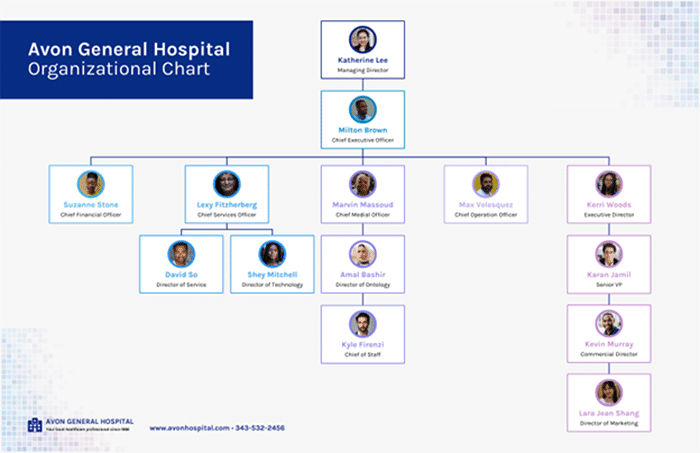words Al Woods
Doing an organizational chart is not as easy as it seems. Many common mistakes occur during the process, such as showing wrong hierarchies or putting employees into more than one branch of your company. This article will help you avoid those mistakes and create an excellent organizational structure for your company while creating an org chart that works.

1. Showing Wrong Hierarchies.
This is very important, and you should be careful because this could cause the morale and productivity to break down in your company, which leads us to mistake numbers.
2. Showing Wrong Reporting Lines.
If you show the people under someone who is not their manager, they might feel confused since they may lack the motivation to work for someone they don’t see as their manager. This also affects the physical location of your employees since they have to travel much further when they have a reporting manager who is far from them in the distance. It will cost you much more money in transportation costs.
3. Misunderstanding Titles.
It is best to make your org chart with correct job titles attached to each position. Otherwise, the employees might get confused about their actual role and responsibilities, which could be very costly for your company if help is not asked by someone who understands the company’s organizational structure.
4. Not Considering Future Changes.
When creating your company organizational chart, it’s crucial to take into consideration any possible changes that may affect this structure, such as promotions, new hires, and terminations.
5. Filtering Out the Roles and Responsibilities.
Each employee should be able to understand their roles and responsibilities in any organization. Otherwise, they work without implementing what is expected from them, leading to many problems such as lack of motivation, misunderstandings between employees and managers, poor working environment, etc.
Therefore, it’s best to take away any technical terms when explaining roles and responsibilities in an easy way that everyone can understand. If you think this might not happen in your company that often, you are wrong since it happens more than you may have thought.
6. Not Showing Who Approves Someone’s Salary or Promotion.
Having a clear hierarchy on who has the power to approve something will provide security of job position because people will know who has the power to take away something good. A good example is incorporating a functional organizational chart.
7. Leaving Out Certain People.
Do not leave out anyone when creating your organizational chart because it is significant for all of them to have a proper role in your company. In addition, you don’t want someone working in your company that you do not need just to feel safe, especially if you are having financial problems in your business.
8. Not Consulting Superiors About the Structure.
It’s best to consult with higher management before making an organizational chart because they might have some valuable input for the changes to be made or know about things you wouldn’t think of yourself. In addition, this would make sure that everyone can understand their roles and responsibilities where they work, which could help build strong teamwork between managers, staff, and employees.
9. Not Involving Everyone in the Company in Creating the Chart.
If you are the only person who creates your organization’s structure, then it would be hard for others to understand or follow what is written on it since they were not consulted at all. They will feel something wrong with their job position if nothing is changed according to how they see themselves working within your company.
This could lead to them losing interest in an organization if their help was not asked while redrafting the structure, which could cost you the money you needed to keep them working there longer than expected. The same thing goes for promotions; people might think that they deserve better than what’s offered just by seeing title names without knowing what each level means.
10. Not Making the Structure Available to Everyone.
Once you redraft your business organizational chart, it’s essential to let everyone have a copy of it to know what is expected from them if someone ever asks about their roles or responsibilities. This would save time for others since they can just show the chart instead of explaining over and over again what each position represents. It will also help increase work productivity, which could be very beneficial for your business, especially if you have financial problems because this often happens when you cannot accomplish goals on time.
11. Having Long Chains of Command.
Making fewer levels in your functional organizational structure will make things much easier for people to understand where they belong instead of having too many chains along the hierarchy, which would make things even more complicated.
12. Not Using 3D Models.
If you don’t want to get confused when reading your chart, use 3D models to help you since they will provide a clearer and more concise vision than just listing names in rows and columns. You can also add graphics, colors, and a Venggage diagram to your structure. It would be easy for people to understand what each level means without reading long titles, which might take them several seconds before they actually know what the position represents.
13. Not Making an Example of an Organizational Chart.
If possible, then create a small organizational chart that shows how all department structures look like. This would help everyone compare their positions within the company by easily comparing it with yours to decide if they will be staying or leaving the company.
It’s easier to make mistakes when creating an organizational chart than creating a flawless one. However, it is not impossible. One way to drastically lessen mistakes is to use pre-made templates where there is little to no possibility of error. Venngage is a great platform to put together your org chart: it’s free, easy to navigate, and no design experience or skills are required to have a professional org chart.




















